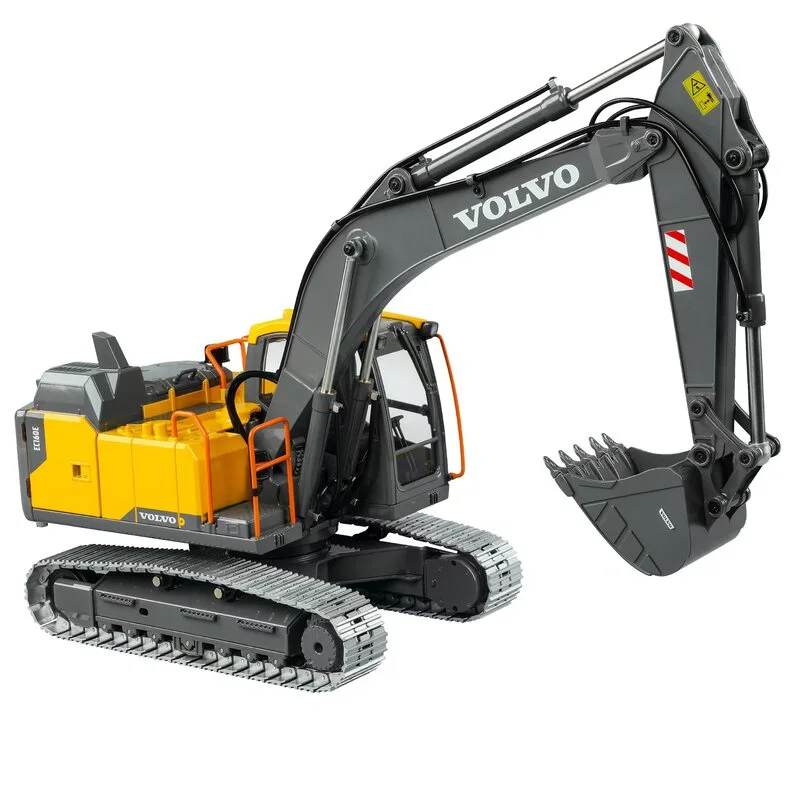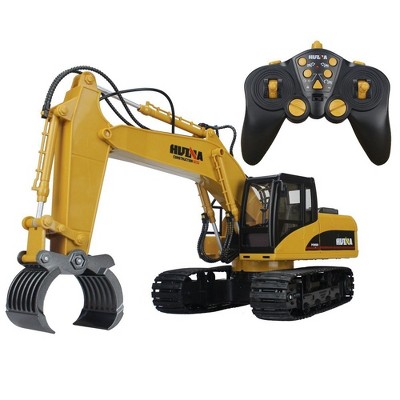The Necessary Features of Excavator That Make Things a Must-Have Tool
Excavators are crucial in the building and construction and landscaping sectors. Their flexible attachments permit for a variety of jobs, from excavating to demolition. In addition, they boast superior digging deepness and reach, powered by durable engines. Operator comfort and small layouts improve functionality in different settings. Nevertheless, what truly sets excavators apart are their innovative hydraulic systems and toughness. Understanding these features can clarify why they are taken into consideration essential tools on any job website.
Flexible Accessories for Improved Functionality
Excavators are powerful machines on their own, the enhancement of functional attachments considerably boosts their capability. These attachments change a basic excavator right into a multi-purpose tool, appropriate for a variety of tasks. Buckets, as an example, been available in numerous shapes and dimensions, allowing operators to dig, scoop, and relocate products effectively. Hydraulic thumbs can be added for enhanced gripping and handling of bulky items, such as logs or rocks.Furthermore, specialized add-ons like augers and breakers permit exploration and demolition work, broadening the excavator's utility on construction websites. remote control excavator. Grapples are an additional choice, perfect for moving and arranging debris. This versatility not only raises efficiency however additionally minimizes the demand for several devices, conserving time and costs. By outfitting excavators with the right add-ons, drivers can tackle diverse jobs, making them essential in the building and construction sector
Superior Excavating Depth and Get To
Excavators are created with exceptional digging deepness and reach, permitting them to maneuver in limited areas and gain access to hard-to-reach locations. This capability is vital for different building and construction and excavation jobs, where traditional machinery might fail. With adjustable boom arms and extendable tracks, excavators can conveniently browse irregular terrain while keeping stability.The excavating depth can differ substantially amongst designs, commonly ranging from 10 to 25 feet, depending on the style and function. This feature allows drivers to dig deep into foundations, trenches, and various other deep structures efficiently. In addition, the reach of an excavator permits precise digging and product handling without repositioning the maker frequently, saving time and labor costs.Ultimately, the premium excavating deepness and reach of excavators make them crucial for experts seeking to complete complex jobs with precision and efficiency. Their flexibility boosts efficiency on job websites, showcasing them as a vital tool in modern building and construction.
Powerful Engine Efficiency

Effective engine performance plays a pivotal role in the abilities of an excavator when it comes to performance and productivity on building and construction websites. A durable engine produces considerable horse power, enabling the equipment to tackle heavy-duty jobs with ease - remote control excavator. This toughness equates right into faster cycle times, making it possible for operators to total projects a lot more quickly.Additionally, powerful engines provide the necessary torque to manage tough surfaces and differed loads, guaranteeing that the excavator can perform successfully under different conditions. Whether it is raising, excavating, or moving materials, the engine's performance directly influences the total operational performance of the machine.Furthermore, advancements in engine innovation have led to improved fuel efficiency, lowering functional expenses while preserving power output. Eventually, the engine's efficiency offers as the foundation of an excavator, attesting its status as an essential tool in the building and construction market
Advanced Hydraulic Systems

Enhanced Lifting Capability
A considerable improvement in lifting capability can be connected to sophisticated hydraulic systems discovered in modern-day excavators. These systems use high-pressure fluid to create greater pressure, permitting operators to lift much heavier tons effortlessly. The engineering behind these hydraulics guarantees peak efficiency, offering an excellent power-to-weight proportion that improves total efficiency. Therefore, excavators can tackle demanding jobs, such as raising large materials or tools, without compromising security. Furthermore, the durable design of hydraulic parts adds to raised resilience and integrity, making them suitable for numerous building settings. This enhanced lifting ability not only reduces the time required for projects but likewise reduces the requirement for added equipment, verifying important for both productivity and cost-effectiveness in the building industry.
Improved Precision Control
Although typical excavators typically battled with precision, contemporary hydraulic systems have transformed control mechanisms, making it possible for operators to execute jobs with amazing precision. These sophisticated systems use symmetrical control valves that enable smoother and much more receptive activities, considerably reducing the margin for error. Operators can now carefully tune the excavator's activities, making it simpler to browse limited areas and deal with delicate materials. Enhanced responses systems better notify drivers of real-time efficiency, ensuring excellent coordination between the machine and operator. This increased accuracy not only enhances performance but also improves safety on job websites, lessening the danger of mishaps. Therefore, contemporary excavators furnished with sophisticated hydraulic systems are indispensable devices for construction and excavation tasks needing precise precision.
Driver Comfort and Visibility
Driver comfort and exposure are important parts in the design of modern-day excavators (remote control excavator). Features such as ergonomic seat layout, boosted exposure options, and effective control designs considerably improve the operator's experience and performance. Focusing on these facets warranties that drivers can work properly and securely in numerous problems
Ergonomic Seat Layout
Comfort and visibility are vital in excavator style, with the ergonomic seat playing an essential function in enhancing the driver's experience. An ergonomic seat is engineered to support the operator's body, decreasing tiredness during long hours of operation. Flexible functions, such as seat height, back-rest angle, and back support, provide to individual choices and advertise perfect posture. These adjustments boost convenience and allow the driver to maintain focus on tasks without pain. In addition, a well-designed seat can provide far better side support, permitting smoother maneuvering when the excavator functions. This thoughtful style not just increases productivity yet additionally adds to general security, making certain that drivers can do their duties properly and efficiently.
Improved Exposure Features
The style of an excavator expands beyond just the seat, with enhanced exposure functions playing a substantial function in operator convenience and general safety. Large home windows and purposefully positioned mirrors supply drivers with a clear sight of their surroundings, reducing dead spots. This style consideration enables far better spatial recognition, which is necessary in active workplace. On top of that, several excavators include rearview video cameras and progressed surveillance systems that aid operators in steering tight spaces. The integration of these visibility includes not only advertises security however additionally decreases operator tiredness by enabling simpler monitoring of job locations. Ultimately, improved visibility adds to more efficient operations and aids ensure that excavators can execute their jobs successfully and securely.
Control Design Efficiency
While maneuvering complex work sites, an effective control design greatly enhances both driver comfort and presence. A well-designed control setup assurances that drivers can access necessary functions with minimal effort, minimizing fatigue throughout long hours. Ergonomic joystick positionings and intuitive button plans enable for smooth operation, making it possible for operators to keep concentrate on the job handy. Furthermore, clear presence of both the workspace and the control panel is essential for safety and security and accuracy. Modern excavators commonly incorporate flexible seating and control settings to suit various operator choices, better boosting comfort. Inevitably, a thoughtfully developed control layout not only improves performance however additionally fosters a much safer working setting by allowing drivers to respond swiftly to transforming problems.
Compact Style for Urban Environments
As urban construction sites typically encounter area constraints, a small layout comes to be important for excavators operating in these environments. These equipments are engineered to browse limited areas, permitting for effective maneuverability in jampacked work sites. A reduced footprint enables them to work very closely to existing frameworks, reducing interruption and optimizing productivity.The small design usually includes shorter Get More Information tracks and a tighter turning radius, facilitating procedure in narrow alleys and restricted areas. Light-weight products add to ease of transportation, making it easier to move the excavator from one location to one more within the city landscape.Additionally, numerous compact excavators are outfitted with attributes such as functional add-ons and extendable arms, boosting their performance while keeping a small size. This versatility permits drivers to deal with a variety of jobs, from excavating to demolition, all while fitting seamlessly right into the restrictions of urban settings.

Sturdiness and Maintenance Considerations
Sturdiness stands as an important consider the performance and durability of excavators, specifically popular metropolitan environments. These devices go through extensive conditions, including varying dirt kinds, extreme temperatures, and high-frequency use. High-grade materials and durable building are needed for making sure that excavators can hold up against these challenges without endangering functionality.Regular maintenance is equally important in protecting sturdiness. Scheduled evaluations, prompt oil changes, and the replacement of used components contribute substantially to an excavator's life expectancy. Operators must additionally take notice of hydraulic systems, tracks, and undercarriages, as these components frequently birth the burden of wear and tear.Investing in durable excavators with extensive upkeep plans boosts dependability and decreases downtime, inevitably resulting in increased efficiency on building and construction websites. Comprehending the interplay in between resilience and upkeep is important for anybody considering the purchase of an excavator for metropolitan tasks.
Regularly Asked Inquiries
How Do Excavators Compare to Various Other Building And Construction Tools?
Excavators attract attention among building and construction equipment because of their convenience, allowing jobs such as digging, grading, and training. Compared to others, their hydraulic abilities use greater performance and power, making them important on different task sites.
What Security Includes Are Consisted Of in Modern Excavators?
Modern excavators incorporate various security attributes, consisting of rollover security systems, alarm systems, and progressed presence improvements. These aspects collaborate to lessen dangers, ensuring operator security while enhancing efficiency on building and construction websites and other demanding atmospheres.

Can Excavators Be Used in Winter Conditions?
Excavators can without a doubt be utilized in wintertime problems, provided they are furnished with appropriate wintertime add-ons and safety measures are taken. Appropriate upkeep and adjustments enhance their performance, ensuring reliable procedure regardless of challenging weather scenarios.
What Is the Ordinary Life-span of an Excavator?
The average lifespan of an excavator usually varies from 7,000 to 10,000 hours of operation. This period top article can significantly rely on upkeep practices, running conditions, and the certain design's toughness and layout attributes.
Just how Do I Choose the Right Excavator Size for My Job?
Choosing the ideal excavator dimension entails assessing task range, website conditions, and product types. Consider elements like reach, deepness demands, and weight capacity to guarantee optimal efficiency and safety and security throughout procedure. Dimension issues significantly in project success. Additionally, the reach of an excavator enables for accurate excavating and product handling without rearranging the maker frequently, saving time and labor costs.Ultimately, the superior digging deepness and reach of excavators make them essential for experts seeking to complete complicated tasks with accuracy and performance. Convenience and exposure are paramount in excavator layout, with the ergonomic seat playing an essential function in boosting the driver's experience. The design of an excavator extends past simply the seat, with improved visibility attributes playing a significant function in driver comfort and overall safety and security. Modern excavators frequently include adjustable seats and control settings to fit various operator preferences, even more enhancing comfort. Lightweight materials contribute to ease of transport, making it easier to relocate the excavator from one location to another within the urban landscape.Additionally, several compact excavators are furnished with attributes such Your Domain Name as extendable arms and functional accessories, enhancing their capability while preserving a little size.